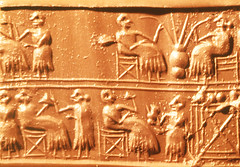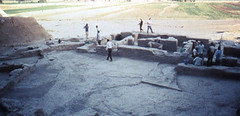Barley Beer
Brewing up a Civilization in the Near East

Drinking scenes at banquets are a recurring theme on Mesopotamian cylinder seals, as exemplified by this impression of a lapis lazuli cylinder seal from Queen Pu-abi’s tomb in the Royal Cemetery at Ur (British Museum 121545), dated to ca. 2600-2500 B.C. In the upper panel, we see a male and female couple sharing a pot of beer, while in the lower panel, a wine aficionado, who has already drained one goblet, is being offered a refill from a droop-spouted jar. (Photograph courtesy of British Museum, length 4.4 cm.)
The earliest chemically confirmed barley beer to date was discovered at Godin Tepe in the central Zagros Mountains of Iran, ca. 3400-3000 B.C. (Chalcolithic/Late Uruk Period).
The artifact that my laboratory analyzed was the upper part of a large wide-mouthed jug in the Near East collection of the Royal Ontario Museum. A notched rope design decorated its exterior, including a knot, with loose ends hanging down, applied between two handles on one side of the vessel. A small hole had been punched through the body wall beneath the knot before firing. Our analysis of a sherd from the jug, with interior criss-cross grooves filled with yellowish material, showed that it was beerstone (or calcium oxalate), a byproduct of barley beer production.
The beer jug was found in the large central supply room of the Godin “Oval,” which was built on the Citadel as a military-cum-trading post in typical lowland architectural style by the proto-Sumerians and/or proto-Elamites along what has been interpreted as a “prehistoric Silk Road.”
It was associated with other important artifacts and botanical finds, including the then-earliest wine jars, pictographic tablets, sling-stones, carbonized barley and lentil and beveled-rim bowls for bread production from the supply room; two more wine jars and a large necklace of semi-precious stone jewelry found strewn across its floor from the adjacent “party chamber;” and “empty” wine jars, a probable wine press and a large funnel, all used in making wine, from a winemaking facility across the courtyard from the supply room.
The ancient Great Khorasan Road, the forerunner of the Silk Road, passed by Godin. It was used to transport wine, semi-precious stones, such as lapis lazuli from Afghanistan, metals including copper, silver and gold, and even such mundane goods as wood, unavailable in the Tigris-Euphrates valley, from the highlands to the lowlands. Much earlier, Palaeolithic humans probably followed the same route eastwards.
We know from later texts that beer–rather than wine or some other drink–was the most common beverage in lowland Mesopotamia. Even the upper class there would normally have drunk beer. Many varieties of beer were made and enjoyed: light, dark, and amber beers, sweet beers, and specially filtered beers.
The interior criss-cross grooving of the jug is very significant. Vessels are often decorated with incisions on the outside, but rarely on the inside; usually they were left rough or smoothed off. Based on the chemical finding of the yellowish resinous material in the grooves being beerstone, the most plausible interpretation of the jug is that it was used to prepare, store or serve beer. It might have been a prototype for the proto-Sumerian pictograph sign for beer (kaş) in which the jar-sign (dug) is shown with various horizontal, vertical, and criss-cross markings on the inside. The grooves also served the practical purpose of concentrating and collecting the bitter, even poisonous beerstone, which would otherwise have spoiled the brew. The six-row barley on the floor of central supply room, where the beer jug was found, was probably grown locally.
The hole beneath the applied rope knot had the likely purpose of accommodating a lone drinking-tube. We might imagine that the shamanistic headman of the Godin clan or the leader of the proto-Sumerian/Elamite trading party was given pride of place at some communal function. Others dipped their straws in through the hole at the top of the jug, but he had a special hole for threading his drinking tube down into the brew.
The Godin beerstone was chemically compared to a modern sample (scraped from inside a brew kettle at Dock Street Brewery in Philadelphia) and one from an ancient vessel almost certainly used to make barley beer. The latter was a New Kingdom Egyptian vessel in the Royal Ontario Museum. The jar, with its flared rim and rounded base, is commonly referred to as a beerbottle by Egyptologists. It was decorated with lotus petals and mandrake fruit in Egyptian Blue pigment. Based on tomb paintings and reliefs, it was used in a special “bread-and-beer” ritual.
R. H. Michel, P. E. McGovern, and V. R. Badler
1993 The First Wine and Beer: Chemical Detection of Ancient Fermented. Analytical Chemistry 65: 408A-413A.
R. H. Michel, P. E. McGovern, and V. R. Badler
1992 Chemical Evidence for Ancient Beer. Nature 360 (Nov. 5): 24.

